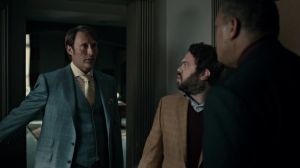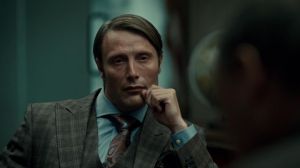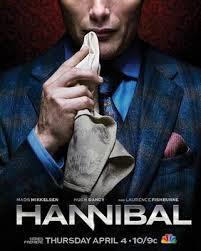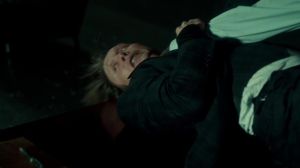When Hannibal first premiered on NBC, I was initially attracted by Mads Mikkelsen in the titular role. However, I soon came to realize that the clothing of the series was superb. Most crime procedurals and serial-killer-dramas are rather drab and lifeless. Hannibal, on the other hand, is vibrant and excitedly colored and, although the palette of the show is very dark, is a beauty to behold. All the environments are carefully controlled to make each frame look like a painting rather than a television show which makes Hannibal, despite its small following and overall lack of viewership, one of the best shows on television. With the third season premiering on June 4, I figured it would be an appropriate time to look back at the previous two seasons and present Hannibal‘s wardrobe in an analytical context. I’ve wanted to write about Hannibal’s suits since I saw the first episode, but due to the lack of information and access to the series on either a streaming service or DVD, I was unable to collect the information I felt I needed. Luckily, Amazon has now added Hannibal to their Prime service which makes it available to stream instantly and for free to all Prime subscribers. I will be presenting my analysis of Hannibal in a series. The first post will focus on explaining the styling of the suits and the exceptions to the rules. In my next post I will be looking at the individual suits and analyzing their fabric. For brevity’s sake I will only be looking at Mikkelsen’s character of Hannibal Lecter. Although his casual wear is very interesting, I will only be analyzing his suits. Perhaps in the future I’ll do a post on his various sports coats, sweaters, and odd trousers.
First off, before I get into the rest of my post, I’d like to correct a couple of misconceptions. First and most importantly, it has been floated on numerous discussion boards that Hannibal’s suits were made by Tom Ford. I’m sorry this is wrong. All of Mikkelsen’s tailored clothing for the first and second seasons was made by the Toronto house Antonio Valente. Antonio Valente is consistently reputed to produce the finest suits in Toronto. In addition to Hannibal, Antonio Valente has provided clothing for other TV and movies such as the miniseries The Kennedy’s, Murdoch Mysteries, and The Music Man, which starred Matthew Broderick. Now, there were three suits which were not made by Antonio Valente, but I’ll get into that later. Second: Mads Mikkelsen is Danish, therefore his name is not pronounced like it looks it should be. “Mads” is pronounced with a very soft ‘d’ almost like “mass” and Mikkelsen is pronounced “miguelsen.” Don’t ask me why because I don’t know, but that’s how they do things in the Netherlands and I think it courteous to pronounce someone’s name that way it was meant to be said. Besides, we all know what Hannibal does to those he thinks are rude.
Onward.
All of Hannibal’s suits for the first season, except three, are made in only one style. What really makes the clothing remarkable though, is the fabric. Nowadays, most suits are either black, grey, or blue. If you’re lucky you might get a mini-herringbone or a self stripe, but you’ll never see a bold Prince of Wales check or a Glen Plaid. Hannibal, on the other hand, is only seen once in a solid-colored suit, instead opting for loud plaids, checks, and stripes. As the only proper way to appreciate this visual festival is to see it, I will attempt to make this post as picture-heavy as possible. I encourage you to click on and enlarge the photos so you can really see the details and patterns.

 I’ll start with the exceptions. In the first episode, Apertif, we only see Hannibal in one suit. The suit is a rather light blue, almost aqua-marine, worsted three-piece with a very light blue windowpane. Characterized by notch lapels, double vents, and a two button front, this suit is only seen in Apertif. In common with the other suits in the series, this suit has flapped slanted pockets and a ticket pocket. Placed directly above the normal pocket on the right side of the suit, the ticket pocket was originally used for exactly what it sounds like, to hold train tickets. When people stopped riding trains as often, the ticket pocket gradually faded out of fashion. Over the past couple of years the ticket pocket has experienced a resurgence in popularity, albeit due to style and not functionality. Still, I am glad to see this detail re-emerging in modern clothing.
I’ll start with the exceptions. In the first episode, Apertif, we only see Hannibal in one suit. The suit is a rather light blue, almost aqua-marine, worsted three-piece with a very light blue windowpane. Characterized by notch lapels, double vents, and a two button front, this suit is only seen in Apertif. In common with the other suits in the series, this suit has flapped slanted pockets and a ticket pocket. Placed directly above the normal pocket on the right side of the suit, the ticket pocket was originally used for exactly what it sounds like, to hold train tickets. When people stopped riding trains as often, the ticket pocket gradually faded out of fashion. Over the past couple of years the ticket pocket has experienced a resurgence in popularity, albeit due to style and not functionality. Still, I am glad to see this detail re-emerging in modern clothing.

 Although we don’t see much of the suit trousers, the pants appear to be flat front, possess a lower-than-traditional rise, and fasten with an extended tab. They may be made with buckle side adjusters. The tapered legs are hemmed without cuffs and with a medium break.
Although we don’t see much of the suit trousers, the pants appear to be flat front, possess a lower-than-traditional rise, and fasten with an extended tab. They may be made with buckle side adjusters. The tapered legs are hemmed without cuffs and with a medium break. 

This is suit was not made by Antonio Valente, rather it is an off-the-rack suit by Brioni. I’ll get my critiques out of the way now. First off, the vest is far too big in the chest. In the photo above you can see how the vest ripples underneath the jacket. A properly fitted vest should be almost skin-tight and should remain very close to the body even when sitting down. Second, all the pants are made with a modern rise. This means that the waistband is only barely covered by the vest. Unfortunately, the pants are not held up with suspenders as they should be when wearing a three piece suit. As a result, the pants tend to sag down exposing the shirt between the vest and the waistband. See the photo above to observe this occurrence. The sleeves on this jacket re also quite long. Although the “normal” suits in this season do have longer sleeves than is currently fashionable, the sleeves on this jacket extend into Mikkelsen’s palm.
The second suit not made by Antonio Valente differs dramatically from the other suits in the season. Not only is it the only solid-colored suit in the series, it also lacks pocket flaps and has slim notch lapels. Just like the previous suit, this grey suit is only seen once, in the third episode Potage. These two suits and one other, which I’ll cover later, are the only ones that were made by someone other than Antonio Valente. According to Mr. Pensato (founder and owner of Antonio Valente), the three ‘outlier’ suits were only selected because the costume designer, Christopher Hargadon, liked the fabric and couldn’t find a similar one anywhere else.
The style of all the other suits in the season is constant. All of them are three piece suits with a two button front, peak lapels, flapped pockets with a ticket pocket, double vents, and a slightly chopped hem. All the vests have a five button front and two lower welt pockets. Some vests may also have two upper breast pockets, but I am not sure. Unfortunately, Mikkelsen repeatedly commits the faux pas of buttoning the last button of his vests. Although these vests are made so that buttoning the last button doesn’t distort the vest, tradition dictates that the last button should always be left open. All the trousers are made in the same style, flat front, two back pockets, buckle side adjusters, low rise, tapered legs, and slanted side pockets. The waistband is fastened with an extended tab, which may either end in a clasp or a button and the trousers are hemmed with a full break and no cuff. Overall these suits have a very Neapolitan feel. The double vents, slanted pockets, chopped hem, and tapered trousers are all trademarks of the Neapolitan style. This was an intentional effect coordinated between costume designer Michael Hargadon and Antonio Petosa to give the character of Hannibal a foreign, European feel.

Other than the lower rise of the trousers, the only other modern detail is the button stance of the jackets. Rather than being placed at the natural waist, the fastening button is placed above the waist. This creates the appearance of longer legs, which in turn makes Hannibal appear taller and more menacing. Usually a high button stance would come with the downside of exposing shirt beneath the fastening button and the trouser waistband, luckily, because all the suits have a vest, this problem is avoided completely.

By speaking with Antonio Petosa, I learned that the slight imperfections with the suits (pants too long, sleeves a bit too long, last button buttoned…) were all intentional. Petosa stated that nobody trusts a man who is perfectly dressed so these imperfections were included to make Hannibal seem more human. In addition, as a psychiatrist, Hannibal wants his patients to trust him, his clothing being less than impeccable allows him to appear more approachable.
Some might comment that the sleeves of the jackets are too long, however I would disagree. It wasn’t always the norm to show shirt cuff beneath the jacket sleeve. With the exception of this first suit, Hannibal’s sleeves are not excessively long. They don’t go as far as his palms and they only extend as far as his shirt sleeves. Although I would much rather he show some cuff, it is not necessarily incorrect for him not to.

An interesting detail of Hannibal’s suits is that the cuffs were either made with four or five buttons depending on the pattern of the fabric. In addition the last button is always left open. The practice of leaving the last button undone has recently come about as a way to “announce” that your suit is bespoke. Before the advent of online custom clothiers, all ready-to-wear suits were made with the sleeves sewn shut, which made them much easier to hem. Functional cuffs or Surgeon’s cuffs were reserved for bespoke or custom clothing as they cannot be hemmed after they are made.

This is the basic styling of all the suits in the series. In my next post I’ll go over each suit individually and discuss their fabric and when they appear in the series. Stay tuned for more “delectable” posts!
Special thanks to Antonio Petosa, without whom this post would have been in error.
All credit for the photos goes to screencapped.net, their resources have been invaluable in the composition of this post.







[…] in which I analyze the clothing of the NBC series Hannibal. If you haven’t already read it, here is a link to my first post. In this post I will be breaking down the fabric of each suit Hannibal […]
LikeLike